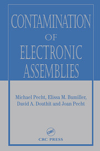Product Details
Features
Summary
Contamination problems have become a major factor in determining the manufacturability, quality, and reliability of electronic assemblies. Understanding the mechanics and chemistry of contamination has become necessary for improving quality and reliability and reducing costs of electronic assemblies. Designed as a practical guide, Contamination of Electronic Assemblies presents a generalized overview of contamination problems and serves as a problem-solving reference point. It takes a step-by-step approach to identifying contaminants and their effects on electronic products at each level of manufacture.
The text is divided into four sections: Laminate Manufacturing, Substrate Fabrication, Printed Wiring Board Assembly, and Conformal Coatings. These sections discuss all aspects of contamination of electronic assemblies, from the manufacture of glass fibers used in the laminates to the complete assembly of the finished product. The authors present detection and control methods that can help you reduce defects during the manufacturing process. With tables, figures, and fishbone diagrams serving as a quick reference, Contamination of Electronic Assemblies will help you familiarize yourself with the origination, detection, measurement, control, and prevention of contamination in electronic assemblies.
